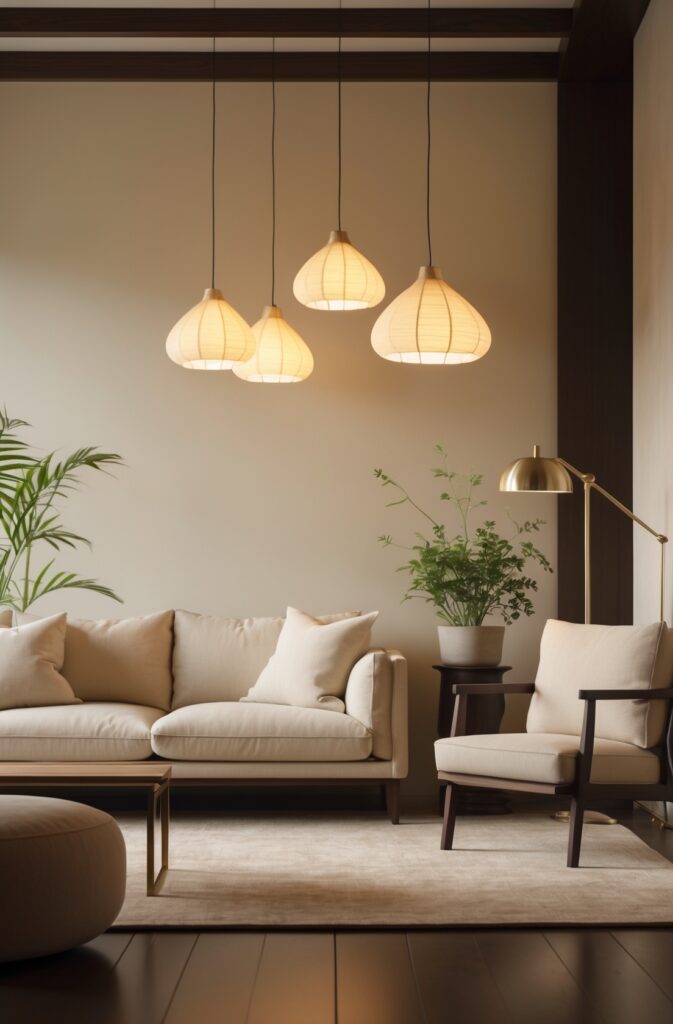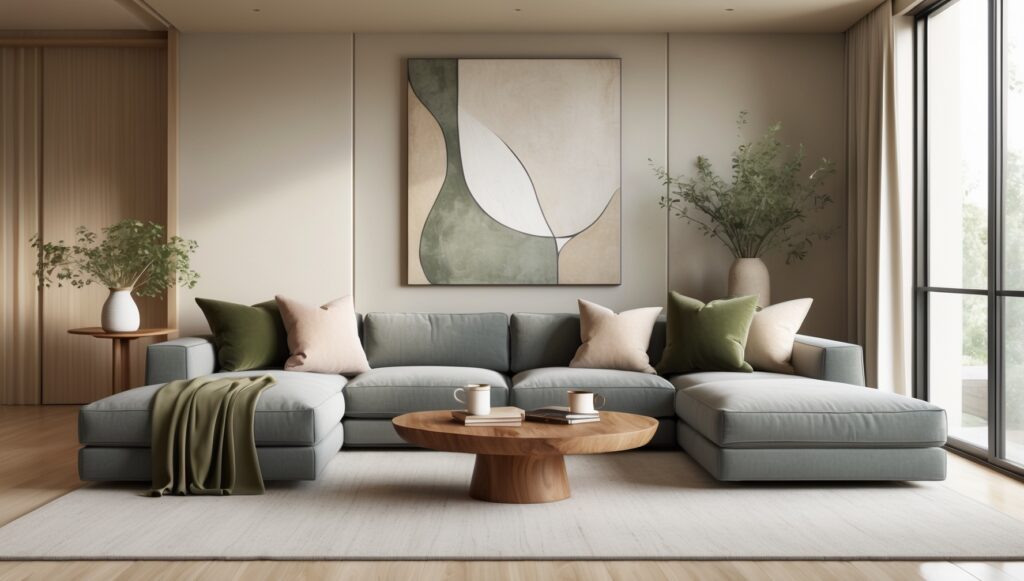15 Japandi Living Room Design Ideas to Transform Your Space Into a Zen Retreat
Creating a peaceful, elegant, and functional living space has never been more relevant than today. With the rising trend of Japandi living room design, I’ve found the perfect way to blend minimalism with warmth, simplicity with texture, and function with calm. If you, like me, long for a tranquil escape within your home, the Japandi style is your ticket to serene sophistication.
What is Japandi Style?
Let’s define this style before diving into ideas:
- Japandi: A hybrid interior design style combining Japanese aesthetics and Scandinavian functionality, emphasizing simplicity, natural materials, and tranquility.
- Wabi-Sabi: A Japanese concept focused on embracing imperfection and transience.
- Hygge: A Danish lifestyle term for coziness and comfortable conviviality.
Japandi pulls the raw, grounded beauty of Wabi-Sabi together with the soft, welcoming comfort of Hygge. Think clean lines, neutral tones, raw woods, and soft textures — all creating a quiet sanctuary.
Why Japandi Works in the Living Room
Your living room is where you unwind, entertain, and connect. The Japandi style promotes:
- Mindful simplicity
- Balanced energy flow (Feng Shui-friendly)
- Long-term sustainability
- Textured comfort without clutter
According to interior design trends published by Pinterest and Houzz, searches for “Japandi” grew over 120% from 2023 to 2024, especially in urban households looking for calm in compact spaces.
1. Neutral Color Palette


Stick with a calm, nature-inspired palette:
- Soft greys
- Warm whites
- Sandy beiges
- Muted charcoals
- Earthy browns
This palette offers a grounding base and sets the stage for natural textures to shine.
2. Low-Profile Furniture


Japandi furniture leans toward minimalism:
- Low-seated sofas and chairs for grounded living
- Simple silhouettes without ornamentation
- Use of natural wood frames, often with exposed grain
Look for solid oak, ash, or bamboo pieces with matte finishes.
3. Textured Layering


Add dimension and comfort using layers:
- Cotton or linen throw blankets
- Soft wool rugs in light tones
- Felt or woven wall hangings
Layering is key to avoiding sterility in a minimal space.
4. Natural Materials


A Japandi living room invites nature in:
- Wood: Floors, shelves, accent furniture
- Stone: Coffee tables, vases, sculptures
- Clay ceramics: Hand-thrown pottery, bowls, lamps
- Linen & cotton: For upholstery and drapery
These materials ground the space with authenticity.
5. Decluttered Surfaces


Minimalism is sacred here. Maintain clean lines by:
- Limiting decorative objects
- Using hidden storage
- Prioritizing functional decor (e.g., books, candles, trays)
This keeps your living room feeling spacious and stress-free.
6. Indoor Plants for Calm


Use greenery to add a breath of life:
- Bonsai trees
- Snake plants
- Monstera
- Fiddle leaf figs
- Dried branches for sculptural value
Plants not only purify air but also elevate harmony.
7. Purposeful Lighting


Layered lighting enhances ambiance:
- Pendant lamps with paper or bamboo shades
- Floor lamps with dimmers
- Table lamps in ceramic bases
Use warm-toned bulbs to maintain a soft, cozy atmosphere.
8. Zen Art and Calligraphy


Introduce wall decor mindfully:
- Minimalist ink art
- Wabi-Sabi inspired brushwork
- Scandinavian black-and-white photography
Art should blend rather than dominate.
9. Sliding Screens or Shoji Dividers


These Japanese elements add both function and form:
- Use them to separate living areas subtly
- Choose materials like wood lattice and rice paper
Perfect for open-concept homes.
10. Organic Shapes and Soft Edges


Avoid sharp, angular lines. Instead, use:
- Rounded coffee tables
- Curved armrests
- Organic-shaped trays and bowls
Soft shapes soften your energy.
11. Functional Storage Solutions


Scandinavian influence means smart storage:
- Hidden drawers in benches
- Floating shelves
- Multi-use ottomans
Out of sight, out of mind—without sacrificing style.
12. Focal Point Fireplace or Feature Wall


Make your space warm and grounding:
- Minimal stone or concrete fireplace
- Slatted wood panel wall
- Built-in shelving for curated objects
This draws the eye without overwhelming.
13. Soft Curtains and Sheers


Let light filter through naturally:
- Choose off-white linen or cotton
- Use ceiling-mounted rods for height
- Avoid heavy drapery
Natural light amplifies Japandi’s peace.
14. Floor Seating or Tatami Accents


Bring in Japanese culture:
- Floor cushions or poufs
- Tatami mats for layering
- Low tea tables for mindful moments
Great for meditation or relaxed gatherings.
15. Personalized Minimalism


Finally, make it yours while staying true to the essence:
- One or two cherished heirlooms
- Handmade crafts from local artisans
- Books you actually read
Intentional living is the goal, not perfection.
Q&A: Japandi Living Room Style
Q. What makes Japandi different from pure minimalism?
A. While minimalism focuses on reducing visual clutter, Japandi layers warmth and texture onto that minimal base. It’s less sterile, more livable, and grounded in nature.
Q. Is Japandi expensive to implement?
A. Not necessarily. The focus is on quality over quantity. Start with key pieces — like a low wood sofa or linen curtains — and layer over time. DIY touches and thrift finds can work beautifully too.
Q. Can Japandi work in small living rooms?
A. Absolutely. Its minimal and airy layout actually makes small spaces feel bigger. Use floating furniture, mirrors, and soft lighting to amplify space.
Q. How can I keep my Japandi space clutter-free long-term?
A. Opt for multifunctional furniture and stick to the “one in, one out” rule. If you bring something new in, let go of something else.
Q. What colors should I avoid?
A. Avoid overly bright or synthetic shades — like neon or bold primary colors. Instead, stick to desaturated, earthy hues.
Final Thoughts
Designing my living room in the Japandi style wasn’t just a decor choice — it was a lifestyle shift. I find myself more relaxed, focused, and at ease in a space that truly reflects balance and calm. If you’re looking to make your home your sanctuary, Japandi is the way.
Take your time to blend form with feeling. Curate instead of collect. Design with intention, and your living room will become more than a room — it’ll be your retreat.

